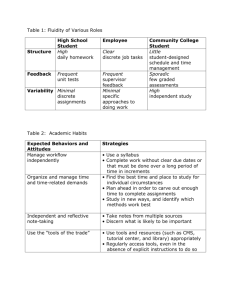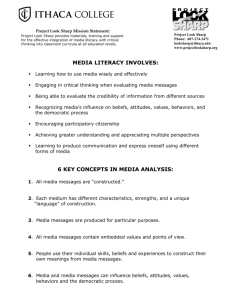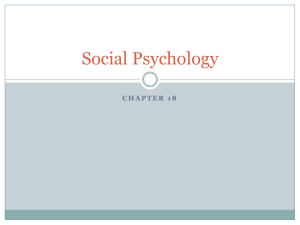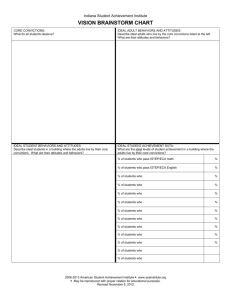SOCIAL PSYCHOLOGY notes s15
advertisement
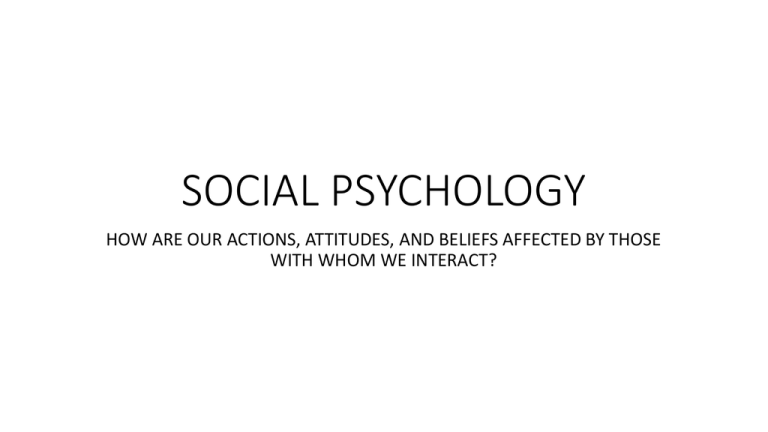
SOCIAL PSYCHOLOGY HOW ARE OUR ACTIONS, ATTITUDES, AND BELIEFS AFFECTED BY THOSE WITH WHOM WE INTERACT? ATTRIBUTION THEORY 1. What reason might you give for a friend who has failed the last 3 psychology tests? 2. What reason might you give for you having failed the last 3 psychology tests? 3. What reason might you give for teenagers who go out and get drunk or high each weekend? 4. What reason might you give if this is you every weekend? 5. What reason might you give if the Astros have a losing season again this year? 6. What reason might a member of the Astros team give for having a losing (or winning) season? ATTRIBUTION THEORY • SITUATION VS. DISPOSITION • FUNDAMENTAL ATTRIBUTION ERROR (FAE) • SELF-SERVING BIAS ATTRIBUTION THEORY • It’s a normal tendency of humans to attempt to explain human behaviors, other’s and our own. • Attribution theory is the understanding that people attempt to explain behavior of others by either internal dispositions or external situations. • Remember: both disposition and situation are relevant and valid • Fundamental Attribution Error (FAE) is our human tendency to emphasize disposition rather than situation when explain other people’s behaviors. • Self-serving bias is our tendency to emphasize our own situation rather than disposition when explaining our own behaviors. FAE Be cautious of this in competition: When you win, it’s the team’s/your talent, but when you lose it was the referee’s calls. ATTITUDES & BEHAVIORS • Attitudes: feelings, often influenced by our beliefs, that predispose us to respond in a particular way to objects, people, and events. • Attitudes influence actions and actions influence attitudes. • Knowing attitudes and wanting to change them leads to persuasion • Central route persuasion: offers evidence aimed to trigger favorable thoughts. It’s route is through thoughtful and direct messages. • Peripheral route to persuasion: doesn’t engage systematic thinking but is very effective in manipulating our emotions leading to snap judgements by utilizing attractive or famous people. Video on persuasion via advertising http://www.youtube.com/watch?v=EC7VLjIw8hY ATTITUDES & BEHAVIORS • The foot-in-the-door phenomena • “Fake it to make it.” Role playing • Cognitive Dissonance ATTITUDES & BEHAVIORS • The foot-in-the-door phenomena: Once a person has agreed to a small task/favor the more likely they will agree to a larger task/favor • Role playing can influence our attitudes. This may be why costars fall into relationships with one another (and fall out as well). A good example of the power of role playing is the Stanford Prison Experiment. Know Phil Zimbardo’s name! ATTITUDES & BEHAVIORS • The Stanford Prison Experiment (SPE) ATTITUDES & BEHAVIORS • How does this happen? One explanation is cognitive dissonance. • We actually experience levels of discomfort when our actions and attitudes don’t align, or when we have misaligned attitude about something. It’s like being a hypocrite, so something has to change, either our actions or our attitudes. • For example, proclaiming you don’t believe in sex before marriage, but then meeting someone you really love and feeling conflicted about your decisions and possibly your actions as well. ATTITUDES & BEHAVIORS • Often our attitudes and beliefs will drive us to act in ways to make events occur that reinforce these beliefs. • This is known as the self-fulfilling prophecy. • Consider the Rosenthal study detailed in the “40 Studies” book. Teachers were told which children were “bloomers” and subsequently treated those students differently, better. “Bloomers” continued to bloom more fully from this reinforcing the teachers’ beliefs that they really were “bloomers.” In fact, there was no difference between these students and the others not labeled. ATTITUDES & BEHAVIORS • Stereotype • Prejudice • Discrimination • Ethnocentrism • In-group/out-group ATTITUDES & BEHAVIORS • Stereotype: a generalized (sometimes accurate but often overgeneralized) belief about a group of people. • Prejudice: an unjustifiable and usually negative attitude toward a group and its members. Prejudice generally involves stereotyped beliefs, negative feelings, and a predisposition to discriminatory action. • Discrimination: in social psychology, unjustifiable negative behavior toward a group and its members. • Ethnocentrism: judging other’s cultures based on one’s own cultural standards. ATTITUDES & BEHAVIORS • In-group/out-group bias HOW OTHERS INFLUENCE US • Groupthink • Social loafing • Social facilitation • Group polarization • Deindividuation • Dehumanization HOW OTHERS INFLUENCE US • GROUPTHINK • The mode of thinking that occurs when the desire for harmony in decision-making groups overrides a realistic appraisal of alternatives. • Avoid it by welcoming diverse opinions, be open to critiques, identify possibly problems, allow debate. HOW OTHERS INFLUENCE US • SOCIAL LOAFING “SLACKING” • The tendency for people in a group to exert less effort when pooling their efforts toward attaining a common goal than when individually accountable • SOCIAL FACILITATION • Improved performance on simple of well-learned in the presence of others • Some believe this explains “home field advantage,” but some research says it is a product of refereeing. HOW OTHERS INFLUENCE US • GROUP POLARIZATION • The enhancement of a group’s prevailing inclinations through discussion within the group. • DEINDIVIDUATION • The loss of self-awareness and self-restraint occurring in group situations that foster arousal and anonymity. HOW OTHERS INFLUENCE US • Solomon Asch’s conformity study • http://www.youtube.com/watch?v=NyDDyT1lDhA • Asch discovered that very specific situational factors influence whether we conform or not: • • • • • • • If one feels incompetent or inferior (due to age, experience, knowledge, etc.) If the group has at least 3 people If the group appears to be unanimous If one admires the group’s status/attractiveness (think frats & sororitites) If one has made no prior commitments/doesn’t have an opinion If others are observing your behavior If there is a cultural expectation of respect for social standards HOW OTHERS INFLUENCE US • Reasons for conformity • Normative social influence: influence resulting from a person’s desire to gain approval or avoid disapproval. • Information social influence: influence resulting from one’s willingness to accept other’s opinions about reality. This is often enhanced by what we perceive as “expertise.” • “Suggestibility” is a subtle form of conformity. This is especially relevant when we have no established opinion, not fully attentive to the situation, or lack the energy to establish a stance. HOW OTHERS INFLUENCE US • OBEDIENCE • Conditions that influence obedience • When the person in charge is in close proximity to participants • When that person is perceived as legitimate (white coat vs. no white coat) • When that person is support by a prestigious institution like a university or the government • When the victim is depersonalized or separated by the one victimizing him/her (Consider how easy it is to be harsh, mean, or a bully in cyber situation…) • When there are no role models for defiance, we are more likely to obey • The Milgram Experiment • http://www.youtube.com/watch?v=BcvSNg0HZwk HOW OTHERS INFLUENCE US • Altruism: The unselfish positive regard for other people’s well being. • Though we want to believe that we are altruistic, we find that when there are more people around, it is less likely we will help. • Diffusion of responsibility helps to explain this. When more people are potentially responsibly for an action, we feel less responsible as an individual. ALTRUSIM & THE BYSTANDER EFFECT • The story of Kitty Genovese • http://www.nydailynews.com/opinion/truth-kitty-genovese-article1.1706942 ALTRUISM • We are more likely to help under the following conditions: • • • • • • • • We have observed someone else being helpful We are not in a hurry The victim appears to need and/or deserve help The victim is in someway similar to us We are in a small town or rural area We are feeling guilty We are focused on others, not preoccupied We are in a good mood. ATTRACTION • What attracts us to one another? • Physical appearance matters, especially features that are symmetrical and youthful. These give cues about reproductive potential • Proximity matters. We tend to be attracted to people who are near us and we interact with regularly. Familiarity breeds attraction: the mere exposure effect: The more we experience it, the more we tend to like it. • Similarity: We tend to be attracted to people who are like us in ways that are important to us. Triangular Theory of Love AGGRESSION • Aggression: any physical or verbal behavior intended to hurt or destroy • Biological explanations: Men tend to engage in more violent acts than women. There is a genetic marker on the Y chromosome that partially accounts for this. Increased activity of the amygdala influences aggressive acts, and reduced activity of the frontal lobe does the same. Testosterone levels influence aggression, too. • Social/environmental influences: Frustration creates anger which can spark aggression. Aversive stimuli such as heat, pain, insults, foul odors, crowds are all environmental factors that can influence aggressive acts. • Social influences: violent models, remember Bandura and the Bobo doll? • Media: Movies & tv shows provide us with “social scripts,” which can be violent and aggressive. AGGRESSION • Frustration-aggression hypothesis: (1939, Dollard) a. Frustration always produces an aggressive urge b. Aggression is always the result of prior frustrations; In 1989, Berkowitz added that the frustration has to be decidedly unpleasant. • Frustration-regression hypotheis: frustration often leads to behaviors characteristic of a much earlier period in life.
